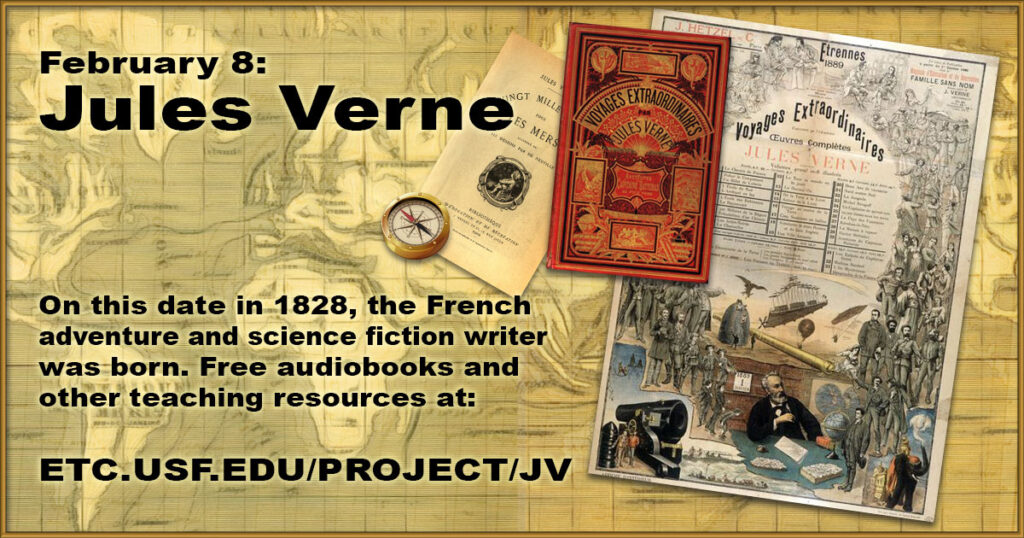Feb. 8: Jules Verne’s birthday

To celebrate Jules Verne’s birthday on Feb. 8, lets take a look at some of his stories and what makes him so special in the history of Science-Fiction. Jules Verne (1828-1905) was a French writer who is widely regarded as one of the founders of modern science fiction. He wrote more than 60 novels, most of them part of his Voyages extraordinaires series, which featured fantastic adventures in exotic locations, often involving scientific inventions and discoveries. Verne was also a well-read and cultured man, who drew inspiration from various sources, including Greek literature, poetry and mythology.
Influence of Greek Literature on Jules Verne
One of the most obvious influences of Greek literature on Verne is his use of the Homeric epics, the Iliad and the Odyssey, as models for his own epic journeys. Verne’s heroes, like Odysseus, often face dangers and challenges in their travels, and encounter mythical creatures and civilizations. For example, in Twenty Thousand Leagues Under the Sea, Captain Nemo and his crew visit the sunken city of Atlantis, which was first mentioned by Plato in his dialogues.
In The Mysterious Island, the castaways are helped by a mysterious benefactor, who turns out to be Nemo himself, echoing the role of Athena in the Odyssey. The name Nemo itself is Latin for “nobody”, the name Odysseus had used to trick a cyclops in the Odyssey. In Around the World in Eighty Days, Phileas Fogg and his companions visit several places that are connected to the Odyssey, such as the Suez Canal, which was supposed to be the site of the Pillars of Hercules, and the island of Crete, where the Minotaur’s labyrinth was located.
Lucian of Samosata
One thing about Jules Verne many people might not know is that he was heavily influenced by the 2nd century AD Greek author, Lucian of Samosata, considered to be the Father of Science-Fiction. Lucian’s most famous work, A True Story, was a satire that included many fantasies in it, including a trip to the moon. We see the influence of that story on Jules Verne when he wrote From the Earth to the Moon.
Another influence of Greek literature on Verne is his use of the ancient genre of the utopia, which was invented by Plato in his Republic. Verne often depicted ideal societies or communities that were based on scientific or social principles, such as the underwater city of the Nautilus, the volcanic island of Lincoln Island, or the aerial city of Albatross.
Verne also explored the opposite of the utopia, the dystopia, which was a term coined by John Stuart Mill in the 19th century, but had its roots in the ancient works of Plato, Aristotle, and Zeno. Verne’s dystopias were usually places where science or technology was used for evil or oppressive purposes, such as the underground city of the Morlocks in The Time Machine, the lunar civilization of the Selenites in From the Earth to the Moon, or the totalitarian state of Robur in Robur the Conqueror.
Influence of Greek Poetry on Jules Verne
Verne was also influenced by Greek poetry, especially by the works of the lyric poets, such as Pindar, Sappho, and Anacreon. He admired their style and their themes, such as love, nature, and human emotions. Verne often quoted or paraphrased their verses in his novels, or used them as titles or epigraphs. For example, in The Children of Captain Grant, the title of the first chapter is “The Shark”, which is a reference to a poem by Anacreon, who compared love to a shark. In The Castle of the Carpathians, the title of the last chapter is “The End of All”, which is a quotation from a poem by Pindar, who wrote that death is the end of all things. In The Meteor Hunt, the title of the novel is taken from a poem by Sappho, who described the beauty of the stars.
Influence of Greek Mythology on Jules Verne
Verne was also fascinated by Greek mythology, which he used as a source of inspiration and symbolism in his novels. Verne often incorporated elements of Greek myths into his plots, characters, and settings, or used them as metaphors or allegories for his themes. For example, in Journey to the Center of the Earth, the protagonists follow the footsteps of Arne Saknussemm, a fictional Icelandic alchemist who claimed to have reached the center of the earth, which was considered to be the realm of Hades in Greek mythology. Along the way, they encounter several phenomena and creatures that are related to Greek myths, such as a volcanic eruption that resembles the fire of Hephaestus, a giant mushroom forest that resembles the Garden of the Hesperides, or a prehistoric sea monster that resembles the Hydra.
In The Master of the World, the antagonist is Robur, a mysterious inventor who has created a flying machine that can also travel on land and water, which he calls the Terror. Robur is a modern version of Daedalus, the mythical craftsman who created the Labyrinth and the wings of Icarus. Robur’s name also means “oak” in Latin, which is a symbol of strength and endurance in Greek mythology.
Other famous works by Jules Verne include Around the World in 80 Days, 20,000 Leagues Under the Sea and Journey to the Center of the Earth. Watch a documentary about him below followed by an adaptation of From the Earth to the Moon.

0 Comments